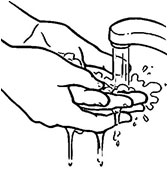Health Hazards in Nail Salons
Biological Hazards
Biological hazards include bacteria, fungi, and viruses. Nail salon workers can be exposed to bloodborne pathogens, such as hepatitis B, hepatitis C, and human immunodeficiency virus (HIV), if they come into contact with infected blood from a co-worker or client. Workers can also be exposed to fungal infections of the nails and feet by touching infected client skin or by using equipment that has not been cleaned.
OSHA's Bloodborne Pathogens Standard, 29 CFR 1910.1030, covers exposures to blood and other potentially infectious materials in workplaces, including nail salons. Employers must evaluate whether an employee may contact with blood or other potentially infectious material. If the employer determines that this risk exists, then the employer must follow the requirements of the standard to protect the exposed employees, including providing training, vaccination, and personal protective equipment.
Steps to Prevent Exposure and Protect Worker Health
 Avoid all contact with blood or bodily fluids.
Avoid all contact with blood or bodily fluids.- Wear gloves, and avoid clients with cuts, open wounds/sores, blisters, or visibly infected skin on their hands, feet, or nails. Many agencies such as the Boston Public Health Commission and the California Board of Barbering and Cosmetology prohibit working on clients with these health issues.
- Throw away disposable gloves immediately after using them.
- Always wash hands with soap and water to avoid spreading germs. Wash hands before and after working with clients.
- Bandage open cuts or broken skin to prevent contact with blood or other potentially infectious materials from a client or coworker.
- If an individual is bleeding, do not touch the blood. Ask the individual to use a cotton ball or tissue to stop the bleeding and to throw the used material directly into the trash once the bleeding has stopped.
- Consider immunization against hepatitis B. Immunization practices can vary by state, so contact your local or state health department for information on current hepatitis B immunization policies in your area. Employers must offer employees hepatitis B immunization without charge if they are likely to be exposed to blood or other infectious materials during their work.
- Clean and disinfect tools after each client per the policies put forward by your state's cosmetology board. Some common steps for cleaning and disinfecting tools are:

- Wear gloves when cleaning and handling disinfectants or tools soaked in disinfectant.
- Wash tools with soap and water. Use a scrub if needed.
- Soak tools in an EPA-registered disinfectant for 10-30 minutes, according to manufacturer directions. Be careful to follow the manufacturer's instructions when mixing the product ratios.
- Rinse in clean water.
- Dry with a clean cloth.
- Store all disinfected tools in a clean, covered area. Only use ultraviolet (UV) sanitizing boxes to store clean and disinfected reusable metal tools. The UV boxes do not disinfect tools.
- Disinfect foot basins and spas after each client and at the end of the day to prevent exposure to workers and other clients. Follow your state cosmetology board's rules on how to clean and disinfect foot basins and spas. The California Board of Barbering and Cosmetology has a helpful foot spa cleaning and disinfection video.
Resources
Resources on How to Prevent Exposure to Biological Hazards and Protect Worker Health
- Bloodborne Infectious Diseases: HIV/AIDS, Hepatitis B, and Hepatitis C. National Institute for Occupational Safety and Health (NIOSH). Gives information on specific bloodborne diseases and how to prevent exposure.
- Selected EPA-Registered Disinfectants. U.S. Environmental Protection Agency (EPA). Lists EPA-registered disinfectants that are effective against certain bloodborne diseases.
- OSHA Safety and Health Topics Pages:
- Bloodborne Pathogens. OSHA. Provides information on the hazards of bloodborne diseases and how to prevent infection.
- Personal Protective Equipment. OSHA. Discusses personal protective equipment (PPE) that is designed to prevent or lessen the severity of injuries to workers when other solutions are unavailable or do not help to lessen exposures to acceptable levels.
General Information About Nail Salon Safety and Health
- Health Hazards in Nail Salons Presentation. OSHA. Training presentation that summarizes the information on OSHA's "Health Hazards in Nail Salons" webpage. Included information about the potential health hazards to nail technicians and other workers, and precautions that employers and workers can take to reduce exposures, injuries, and illnesses.
- Stay Healthy and Safe While Giving Manicures and Pedicures: A Guide for Nail Salon Workers (EPUB | MOBI). This publication is also available in:
- Tips on Worker Safety. Labor Occupational Health Program (LOHP) and California Healthy Nail Salon Collaborative. Provides general tips for staying safe and healthy while working in nail salons. Also available in Vietnamese.
Help for Nail Salon Owners and Employers
- Bloodborne Pathogen Exposure Incidents Fact Sheet. OSHA. Describes how to report an exposure to a bloodborne disease and employers' responsibility to provide a follow-up medical evaluation to the exposed worker(s).
- Bloodborne Pathogens Standard Fact Sheet. OSHA. Describes the requirements of OSHA's Bloodborne Pathogens Standard.
- Information for Employers Complying with OSHA's Bloodborne Pathogens Standard. National Institute for Occupational Safety and Health (NIOSH). Provides employers with an explanation of OSHA's Bloodborne Pathogens Standard and a list of resources.
- Model Plans and Programs for the OSHA Bloodborne Pathogens and Hazard Communications Standards. OSHA. Includes a model exposure control plan to meet the requirements of OSHA's Bloodborne Pathogens Standard.
- Personal Protective Equipment (PPE) Reduces Exposure to Bloodborne Pathogens, Fact Sheet. OSHA. Describes how to select and use PPE to prevent infection from bloodborne diseases.
- Small Business. OSHA. Provides links to many OSHA resources and information specifically for smaller employers, including safety and health tools and publications, easy-to-follow guides for specific OSHA standards, and descriptions of benefits that small businesses receive from OSHA.


